Friday, December 28, 2007
Chistmas Wrap-Up-
Amy was in charge of all the food- the way we do food here is that I cook during the week, but if anything calls for planning or expertise, she does it. So it was real bummer when she got up with a stiff neck Christmas morning, and then came up from the basement at 9:04 a.m. saying "I dropped the butter and when I bent down to pick it up, my neck went out".
Ouch. I mean, I never had a neck go out, but I've had my back go out in spasms, and it's not fun.
She was barely able to walk, but insisted on presiding over the kitchen all day and, with much help from our friend Anne from Vermont, dinner made it on, and was enjoyed by all.
It wasn't until around 5 pm that Amy suggested we might want to go to the emergency room, as she could not actually move without 10th-level pain.
They prescribed some very nice drugs, and she had a half-nights sleep last night and is feeling somewhat better today- though I went and did the farmer-thang and watered the six horse at the barn. Got horse shit all over my pants and gloves and remembered how it feels to care for outdoor animals in winter, back when I had ducks. You know, it's good feeling, no matter how much ice-encrusted shit you have on you when you get home. Ice is ice, and you live in New England and you expect something else than to wade in horse shit? Forget it- haul the damn water out in wheel-barrows over the ice to the horses. That's life.
We're covered in frozen horse-shit, but all is happy here.
Tuesday, December 11, 2007
Our Latest Catalog-

The Book Elves love Christmas, but they get very, very competitive when shopping for a Christmas tree. After being banned by the local tree farm after a rather ugly incident involving the mayor’s mother and a chainsaw last year, they decided to cut their own in our back woods.
Now here’s the thing about “home-grown” trees- they tend to be “home” in more ways than one. The first inkling we had that they might have brought more into the house than just a balsam fir came when a sleepy chipmunk landed on the mantle, and soon there were a variety of songbirds flying around the living room. It was actually very cute and Christmassy and lent a festive air to our Christmas party last Thursday evening -the bright colors and cheerful songs of the chickadees, jays, cardinals and titmice were quite charming.
And then the squirrel and the red-tailed hawk popped out...
But before they turned our living room from a scene from Dickens’ ‘A Christmas Carol’ to a scene from a Bruce Willis “Die Hard” movie, the Book Elves finished our latest catalog-
Catalog #310: BOOKS ON THE DECORATIVE ARTS, including folk art, interiors, metalware & iron, textiles, & other “Americana” & related subjects” features 271 fully described books and catalogs.
The catalog may be browsed on our website.
Tuesday, December 04, 2007
Our New December Catalog-

The Book Elves love decorating for Christmas, and they love seeing the big, 80-foot maples out front strung with brightly colored lights. But after last year's unfortunate 'incident' with the rented cherry picker and the power lines, they knew they had to come up with an alternate method of stringing them.
The Book Elves are nothing if not resourceful (or ever-so-slightly addled) and so they trundled on down to our local Radio Shack and bought a radio-controlled airplane and two-dozen boxes of new light strings. It was a simple enough idea- a radio-controlled airplane flies as high as the trees and is, by definition, “controllable”. It is also quite powerful enough to attach a few strands of Christmas lights to, and so they did, and away the plane went, round and round the tree.
Personally, I have always found it a pity that some of the Book Elves more unusual and interesting ideas usually turn out to have completely unexpected consequences, especially for unsuspecting bystanders...
But before they hog-tied the neighborhood carolers (and their dog) to a tree with sixteen strands of “Merry Christmas Blinking Frosty Lights”(tm), the Book Elves finished our latest catalog-
Catalog #309: RECENT ACQUISITIONS & OTHER INTERESTING BOOKS ON ANTIQUES & THE ARTS, DECEMBER, 2007, features 217 books and catalogs on antique furniture, silver, ceramics, glass, textiles, folk art, and many related topics.
HIGHLIGHTS INCLUDE-
-Barber's scarce 1893 catalog of American ceramics
-Several nice early 19th century miniaturist's manuals
-A nice 1873 Elkington Silver & Electroplate catalog
-A very scarce Henry Wood Erving pamphlet
-A superlative copy of French's 1879 'Art and Artists in Connecticut'
-The book issued at the 1925 opening of the American Wing, limited to 500 copies
-A scarce 1884 book on electric lighting in the home
-A copy of Isham's 1928 'Early American Houses', one of 35 copies on rag paper
-A scarce 1816 pamphlet describing the Piccadilly exhibition of Napoelon's captured personal carriage and its luxurious contents
-An 1898 monograph on woollen fabrics of the Oudh provice of India
-A unique court exhibition of old British sherry labels, used in the noted 1967 case of Vine Products v. Mackenzie
-An important 1925 pictorial survey of Art Deco in France by Henry Van de Velde
and much more!
The catalog is posted online.
We also have printed copies available. Please send us your address if you would like a free copy.
Tuesday, November 06, 2007
Our New Books on Silver Catalog

It’s nearly Thanksgiving, which means a big dinner, which means the Book Elves have to polish the silver. The Book Elves hate polishing the silver. This year they decided to “shorten” the task and had a go at it with a concoction they saw advertised on late night tv called “Blast Off! –Super Silver Polish and Drain Cleaner”.
It turns out there were two reasons it was called “Blast Off!”. The first is that it removed the tines from all the forks. The second is that it turned out to be highly flammable, as they found out when they turned on the gas stove burner to boil water for tea in the middle of the job.
But before the explosion gave the turkey (and the rest of the kitchen) that “nice smoky flavor” and we got re-acquainted with the friendly fire-department folks from three adjoining towns, the Book Elves finished our latest catalog-
Catalog #308: BOOKS ON SILVER & SILVERSMITHS features 286 books and catalogs on antique silver, silversmiths, silversmithing and related topics.
The catalog is posted online, and we also have printed copies available. Please send us your address if you would like a free copy.
Tuesday, October 30, 2007
A Grave Affair-

The Book Elves love Halloween, and always spend a great deal of time preparing a huge Halloween party. Everyone is still talking about last year’s “5000 Pumpkin Bonfire Roast”, but under the terms of the restraining order taken out by the Fire Dept. they won’t be repeating that again anytime soon. This year they decided to stage a haunted house with a twist- real ghosts. They had this “Yuri Geller Ghost Summoner” kit they bought on late-night QVC, and I’ll be darned if the silly thing didn’t actually work! The upside was that the ghosts were a great hit at the party and scared the bejeezus out of all the kids, so the Book Elves have lots of candy left over to eat themselves. The downside was that ghosts turned out to be, well, let’s just say “unpredictable”. Call me crazy, but I wasn’t aware that ghosts did things like fill your car with lime jello. We’re also still looking for the bathtub, which was last seen galloping down the street, singing “Feelings”...
But before they found themselves stripped naked, painted orange and stranded on the porch roof, the Book Elves finished our latest catalog-
“A GRAVE AFFAIR- Old & Interesting Books on gravestones, cemeteries, epitaphs, mourning customs, funerals & funeral customs” is now ready, and posted on the web.
Highlights include-
-an 18th century manuscript collection of epitaphs.
-a nice copy of one of the greatest English epitaph books, the 1631 “Ancient Funerall Monuments”, written by John Weever, “connoisseur of graveyards, tobacco-enthusiast, sycophant, satirist, dwarf, [and] penner of dirty ditties”
-a pair of interesting 1930s “Modern” style German gravestone trade catalogs.
-an 1851 manual to good taste in cemeteries by a man who hated cherubs.
-an 1820 American manuscript funeral sermon for the minister’s wife.
-a fantastic French Victorian design book of memorial and other hairwork.
-The ceremonies at the 1883 dedication of the Robert E. Lee mausoleum at Washington and Lee University.
And much more!

Printed copies are also available.
Please let us know if you would like one.
Tuesday, October 16, 2007
New Catalog- Books on Furniture

As I mentioned a few weeks ago, the Book Elves have become country auction addicts (though they prefer the word “enthusiasts”). Their addiction (sorry- “hobby”) has inexorably led them to another pursuit- collecting antique furniture. They began with rocking chairs, which was fine until they bought so many of them that there was no longer any room to rock on the front porch. One or even two dining rooms tables is fine, but six? And then came the project to see how many highboys you could stuff into an 11-room house (the answer, by the way, is 62 and a half. Don’t ask about the “half”, it’s a sore subject around here).
But before they glanced in their rear-view mirror, while doing 70 in the high-speed lane of the Massachusetts Turnpike, to see an antique 18th century highboy fly off the roof rack and instantly become a collection of antique 18th-century kindling when the semi ran over it, they finished our latest catalog-
CATALOG 306: BOOKS ON FURNITURE & CABINETMAKERS features 240 books and catalogs on antique furniture, cabinetmakers, tools, and related subjects.
Highlights include-
-A fascinating 1835 treatise on designing and drawing cabinet furniture.
-An uncommon 1916 book on polychromatic decorative turning.
-An interesting 1870s trade catalog of Gothic-Revival furniture.
-An early, 1841 edition of a classic American cabinetmaker’s manual.
-A beautiful collection of 1820s hand-colored plates of French Empire furniture designs.
-A striking 1867 book of colored design for marquetry cabinetwork.
-and a wide variety of classic and uncommon books and catalogs on American, English, European and Oriental furniture!
The catalog may be viewed on our website, or we have free printed copies available. If you would like one, please ask.
Tuesday, September 25, 2007
New Catalog of Auction Catalogs-
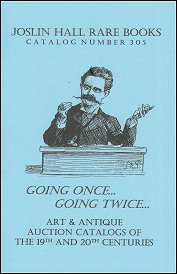 One of the things the book elves love about country life is going to country auctions. There just seems to be no end to the stuff we need that they find there (although I am thinking of returning the goat). But before the book elves wheeled into the yard last night with 3 boxes of Limoges soup bowls and a concrete birdbath in the shape of Mel Torme, they finished our latest catalog-
One of the things the book elves love about country life is going to country auctions. There just seems to be no end to the stuff we need that they find there (although I am thinking of returning the goat). But before the book elves wheeled into the yard last night with 3 boxes of Limoges soup bowls and a concrete birdbath in the shape of Mel Torme, they finished our latest catalog-“GOING ONCE... GOING TWICE...” ART & ANTIQUE AUCTION CATALOGS of the 19th and 20th CENTURIES
This catalog includes 234 auction catalogs and a few related books, featuring notable sales, great estates, famous collectors, ancient art, books, ceramics & glass, furniture & Americana, Eastern arts, fine arts, silver & jewelry, and much more!
It can be browsed on the web.
HIGHLIGHTS include-
-A copy of the rare 1886 ‘Subscriber’s edition’ of the very first Blockbuster auction ever held in America.
-The famous 1929 sale of an entire Elizabethan paneled room, with stained glass windows, at Gilling Castle.
-The 1938 catalog to the very first Parke-Bernet auction.
-A wonderful 1905 auction of Japanese arms & armor put together by a famous Japanese monk/dealer who worked with Edward Morse.
-Many important American furniture & antiques sales, including Brix, Haskell, Little, Nicholson, Reifsnyder, and Sussel.
-A nice 1923 catalog of two private collections of Barye bronzes.
-The 1971 Movie Prop auction of 20th Century Fox property where the entire fleet of gigantic scale, working models of American and Japanese ships, as well as the modified airplanes, used in the movie ‘Tora! Tora! Tora!’ were featured.
-Auctions devoted to canes, cats, cutlery, fashion, folk art, garden statuary, globes, needlework, and much, much more!
We also have printed copies available.
If you would like a printed copy,
please send us your mailing address.
Monday, September 24, 2007
The Affair of the Diamond Necklace- Part 2
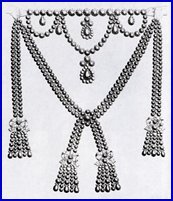 [Click here for our story so far...]
[Click here for our story so far...]The first Marie Antoinette knew of her "purchase" of the necklace was when the jewelers (most humbly and very, very anxiously) sent her a dunning letter for the gigantic unpaid bill. Then, as they say, all Hell broke loose. The scandal became public; the Cardinal was denounced, and Jeanne was arrested along with just about everybody else who had ever as much as shaken hands with the Cardinal.
Acting against some very good advice, Marie Antoinette insisted on a trial for the Cardinal on the charge that he was guilty simply because he had believed that she was capable of having the sort of "relationship" with him he had thought she had. This, of course, played right into the hands of the Queen's numerous enemies who were only too happy to have publicly broadcast the exact nature of what the Cardinal had thought were the Queen's morals, or lack thereof.
There followed a sensational trial, which was ostensibly about the Cardinal's actions but was really about the Queen's reputation. Jeanne's lawyer was Maitre Doillot, a respected advocate who was in somewhat over his head in dealing with Jeanne. He was the family lawyer of the Paris Police Lieutenant General, and had been recommended to Jeanne by that worthy as a favor -for what we will not speculate, though many others did at the time. The Count Beugnot, himself a lawyer (and another one of Jeanne's former lovers) had turned down her plea that he defend her, and had this to say about Maitre Doillot-
 "Doillot had been in practice before the Paris bar for many, many years, and not without renown. Deep in his sixties or beyond, he had retired to his study, where he was still consulted as an eminent jurist. Even a sage old gentleman such as this could not with impunity survive close contact with the Countess de la Motte. She completely turned his head. He believed implicitly all the tales she spun him, became emotionally involved with his client and put up an impassioned defense of her innocence, making his debut in the case with the publication of a trial brief, the most extravagant defense plea ever to flow from the pen of an attorney in all the years since attorneys first began composing defense pleas. Fantastic as a tale out of 'The Arabian Nights', it enjoyed, nonetheless, a sensational success. And to think that it was the composition of a venerable white-wig of seventy summers!".
"Doillot had been in practice before the Paris bar for many, many years, and not without renown. Deep in his sixties or beyond, he had retired to his study, where he was still consulted as an eminent jurist. Even a sage old gentleman such as this could not with impunity survive close contact with the Countess de la Motte. She completely turned his head. He believed implicitly all the tales she spun him, became emotionally involved with his client and put up an impassioned defense of her innocence, making his debut in the case with the publication of a trial brief, the most extravagant defense plea ever to flow from the pen of an attorney in all the years since attorneys first began composing defense pleas. Fantastic as a tale out of 'The Arabian Nights', it enjoyed, nonetheless, a sensational success. And to think that it was the composition of a venerable white-wig of seventy summers!".The Abbe Georgel called Doillot's first plea "a tissue of lies, of striking improbabilities, contradictions and anachronisms". Doillot's own brother agreed-
"The man has either gone stark raving mad or Madame de la Motte has bewitched him as she did the Cardinal".
After much scandal mongering in both the courtroom and the streets the Queen's enemies won and the Cardinal was acquitted. Others were not so lucky- the Count Cagliostro was exiled from France, and eventually returned to Italy where he was arrested and convicted on charges of practicing Freemasonry; he died in prison in 1795.
Jeanne was convicted and whipped, branded, and thrown into the Bastille at which point she may (or may not) have had a fling with its Governor, the poor Launay, who would lose his head at the hands of the mob when they stormed the ancient fortress a few months later.

Jeanne was now a favorite of the anti-Antoinette faction, which was growing quickly in France, and she was able to intrigue to escape the country and made her way, with her husband, to London.
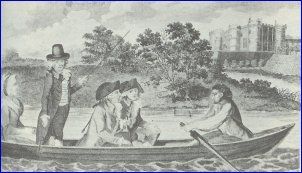
Once there she immediately set out on a plan of revenge against the Queen which took the form of her famous "Memoires Justificatifs de la Comtesse de Valois de la Motte". These contained her own highly slanted version of her life and the Diamond Necklace Affair, as well as some thirty pieces of correspondence she claimed had passed between the Cardinal and the Queen.
"From the moment of my arrival in London," she wrote, "my first and only thought had been publication of my justification for the eyes of all the world... I too would have preferred to spare the honour of the Queen, and I tried to warn her Majesty that I was in Possession of certain letters...incriminating her and exculpating me... All I asked in return was restitution of property rightfully mine which had been seized, after an iniquitous verdict, to enrich the coffers of the King. But I really never considered it likely that the French court would capitulate to those terms, and besides, my main goal was public vindication. To this purpose, then, I eagerly took up my pen, denying my feeble, tortured body even the minimal physical requirements of nourishment and sleep until my memoirs should be ready for publication. Although we were obliged to borrow money to defray the costs of printing, five thousand copies in French have now come off the press, and three thousand more in English; the latter went on sale at a guinea each in New Bond Street shops."
The readers of England and France could not get enough of the Countess's memoirs, although what you thought of them depended on which side of the Royal table you sat on- "a cesspool of calumny" was the verdict of the Abbe Georgel, friend and secretary of Cardinal Rohan. In October of 1789 a "Second Memoirs justicatif", much more barbed and venomous than the first, was rushed to the printers, another direct attack on the Queen by Jeanne, published in French and English and distributed in Paris where it stirred the mobs to a new frenzy.
Mirabeau said of the Countess- "Madame de La Motte's voice alone brought on the horrors of July 14 and of October 5" (the storming of Versailles and the slaughter of the troops there by the 'Women's Army').
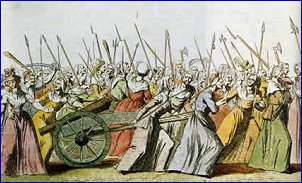
Her works spawned a storm of other pamphlets, each one trying to outdo the other in decrying the licentiousness and debauchery of the Queen. Frances Mossiker, in "The Queen's Necklace", notes, however, that's Jeanne's works were the most influential-
"There were other attacks perhaps more obscene, but they were published under noms de plume and therefore were never as pungent and convincing as those signed by a real-life name, a name famous, moreover, throughout Europe ever since the Necklace Trial".
In 1791 the Countess's two volume "Story of My Life" came off the presses, but Jeanne would not live to enjoy its fruits. In early June the London newspapers reported that a London bailiff had appeared at her lodgings to serve an order for her mounting debts. Others said that the men were actually secret agents sent by the Duke of Orleans; that was what Jeanne believed, and to get away from them she barricaded herself in and then climbed out a third floor window, falling to the street below. Badly injured, she lingered in extreme pain through the hot weeks of July and into August, when, on August 23rd, 1791, she died. She was buried a few days later in the churchyard of St. Mary's, in Lambeth.
The Queen against whom Jeanne had intrigued for so long survived her by just two years, one month, and 23 days, before mounting the steps to the guillotine in Paris to the howling delight of the mob.
Thursday, September 20, 2007
Our New September-October Catalog
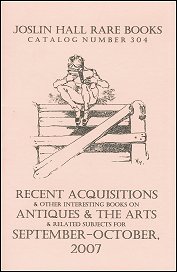 Our new catalog #304, "Recent Acquisitions & other interesting books, September-October, 2007" has now been on our website. It features 138 books and catalogs on all aspects of art, antiques, architecture and trades, as well as some great new remainder books!
Our new catalog #304, "Recent Acquisitions & other interesting books, September-October, 2007" has now been on our website. It features 138 books and catalogs on all aspects of art, antiques, architecture and trades, as well as some great new remainder books!
Monday, July 30, 2007
The Affair of the Diamond Necklace-
"The Queen's death must be dated from the Diamond Necklace Trial".
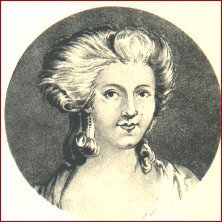 The trial, and the subsequent Memoirs of its chief feminine player, the Comtesse de la Motte, are credited by many historians with being the gust of foul wind which finally fanned the long-smouldering fire of popular discontent into the uncontrollable conflagration of the French Revolution.
The trial, and the subsequent Memoirs of its chief feminine player, the Comtesse de la Motte, are credited by many historians with being the gust of foul wind which finally fanned the long-smouldering fire of popular discontent into the uncontrollable conflagration of the French Revolution.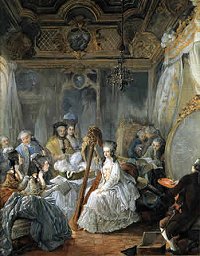 The tale is long, complex and sordid; it has several different versions (depending on whose memoirs you read), and has been told many times, most recently in a beautifully costumed Hollywood version starring Hilary Swank. The movie, which includes a stirring performance by Miss Swank as the Countess, takes some (but not all) of the Countess's claims at face value, which is another way of saying that it takes extreme liberties with what most historians regard as the actual truth.
The tale is long, complex and sordid; it has several different versions (depending on whose memoirs you read), and has been told many times, most recently in a beautifully costumed Hollywood version starring Hilary Swank. The movie, which includes a stirring performance by Miss Swank as the Countess, takes some (but not all) of the Countess's claims at face value, which is another way of saying that it takes extreme liberties with what most historians regard as the actual truth.Although she claimed to be descended from royalty, it is now generally agreed that Jeanne de Saint-Remy de Valois, Comtesse de la Motte, came of what might be termed "humble origins" and basically talked, schemed and slept herself almost all the way to the Royal Chambers at Versailles.
 Jeanne carried on an affair with the Cardinal Louis Rene Edouard, Prince de Rohan, a man more attuned to matters earthly than spiritual. Jeanne also borrowed money from the Cardinal, and was soon deep in his debt. For his part the Cardinal was out of favor with Marie Antoinette, and was anxious to get into the Queen's good graces, if not her bed. Jeanne, who was undertaking her own campaign to gain access to the Queen and have her "family estates" "returned" to her, persuaded the Cardinal that she had the Queen's ear and could arrange reconciliation.
Jeanne carried on an affair with the Cardinal Louis Rene Edouard, Prince de Rohan, a man more attuned to matters earthly than spiritual. Jeanne also borrowed money from the Cardinal, and was soon deep in his debt. For his part the Cardinal was out of favor with Marie Antoinette, and was anxious to get into the Queen's good graces, if not her bed. Jeanne, who was undertaking her own campaign to gain access to the Queen and have her "family estates" "returned" to her, persuaded the Cardinal that she had the Queen's ear and could arrange reconciliation.The gullible and perhaps somewhat oversexed Cardinal agreed and the Countess arranged a correspondence between him and the Queen. His letters to Marie Antoinette were real enough, but never delivered; the Queen's return letters were forgeries produced by Jeanne herself, or possibly her husband, or perhaps her "secretary" and lover, the gallant former-cavalier Retaux de Vilette.

 The famous and scandalous Count Cagliostro, alchemist, healer and all-round man-of mystery, had been befriended by the Cardinal, and the Cardinal relied on Cagliostro's direction and ability to see into the future to direct his dealings with the "Queen". Cagliostro, who was nobody's fool, went into trances and told the Cardinal that he saw the Cardinal being favored by the Queen and rising to a very high post in the government.
The famous and scandalous Count Cagliostro, alchemist, healer and all-round man-of mystery, had been befriended by the Cardinal, and the Cardinal relied on Cagliostro's direction and ability to see into the future to direct his dealings with the "Queen". Cagliostro, who was nobody's fool, went into trances and told the Cardinal that he saw the Cardinal being favored by the Queen and rising to a very high post in the government. The diabolical farce seemed to reach its climax with a midnight rendezvous in the Grove of Venus at the Palais-Royal Gardens, between the Cardinal and "Marie Antoinette" -actually an actress (or prostitute, or perhaps both, who could keep track at this point?) named Mademoiselle Leguay d'Olivia, who bore a remarkable resemblance to the Queen... and then the extravagant and fabulously costly diamond necklace entered the scene.
Ah, the necklace...
 The Diamond Necklace had been made several years earlier "on speculation" by a firm of Parisian jewelers who had assumed they could sell it to Madame du Barry. When that did not work out they tried to interest Marie Antoinette in the necklace, and although she had been tempted, she considered it too extravagant and had refused to purchase it. Now the jewelers, teetering on the edge of bankruptcy because of the interest payments on the money they had borrowed to buy the stones, approached the Countess, who openly boasted about how close she was to the Queen, and asked her to persuade Antoinette to buy the overwrought bauble which was worth as much as a full-rigged warship.
The Diamond Necklace had been made several years earlier "on speculation" by a firm of Parisian jewelers who had assumed they could sell it to Madame du Barry. When that did not work out they tried to interest Marie Antoinette in the necklace, and although she had been tempted, she considered it too extravagant and had refused to purchase it. Now the jewelers, teetering on the edge of bankruptcy because of the interest payments on the money they had borrowed to buy the stones, approached the Countess, who openly boasted about how close she was to the Queen, and asked her to persuade Antoinette to buy the overwrought bauble which was worth as much as a full-rigged warship.Jeanne shrewdly took the matter to the Cardinal, who was very much inclined to negotiate a purchase he thought would endear him further to Marie. Once more the Cardinal consulted the Count Cagliostro, and once more Cagliostro went into a trance and foresaw the Cardinal enriched and rewarded by the Queen with a post at the highest rank of the government.
More outrageous lies, deception and forged letters ensued, and in the end the Queen agreed to purchase the necklace, or so the lovesick Cardinal and desperate jewellers were led to believe. The jewelers delivered the necklace to the Cardinal, and the Cardinal delivered it to a trusted servant of the Queen (or so it appeared) and then the necklace simply vanished!
Gee, bet you didn't see that coming, eh?
Next: Scandal, Trial, & Revolution!
Tuesday, June 12, 2007
Our New Summer Catalog-

The Book Elves hate mowing the lawn, and will try just about anything to make the job easier. As gas prices rose last summer they decided to experiment with what they termed “natural mowers” which turned out to mean livestock. Sheep were very good at clipping grass to a uniform height but were also very timid and kept taking cover on the front porch whenever the neighbors let their dogs out. Goats were less timid, but after they chased the dogs back to the neighbors’ yard, the goats proceeded to eat more than 300 tulips and daffodils that they found there. This year the Book Elves have returned to machinery for mowing, but before they duct-taped three old Sears Craftsman riding mowers together and took out an entire row of azaleas, they finished our new Summer catalog-
"Recent Acquisitions for Summer, 2007" features 131 old and new books on antiques, arts, and related topics, including ceramics, furniture, glass, silver, folk art, and much more! You can browse the catalog online.
Highlights include-
* The 1835 edition of one of the most outspoken cabinetmaking books of the 19th century
* The elegant 1883 catalog of the Joseph Mayer Museum of Medieval manuscripts, ivory carvings and other arts.
* A very scarce, privately-printed 1928 catalog of the Woodward Collection of early Maiolica.
* A nice 1907 trade catalog of ice harvesting tools and equipment.
* A very clean copy of Thompson's 1860 "Universal Decorator", filled with colored plates and articles about Victorian arts.
* A very interesting 1883 study of practical electric lighting.
* An unusual Czech catalog of Art Deco furniture.
* A good set of Waagen's 5-volume 1854 study of art collections in England.
-and much more!
See the catalog here.
Wednesday, June 06, 2007
Down by the River...
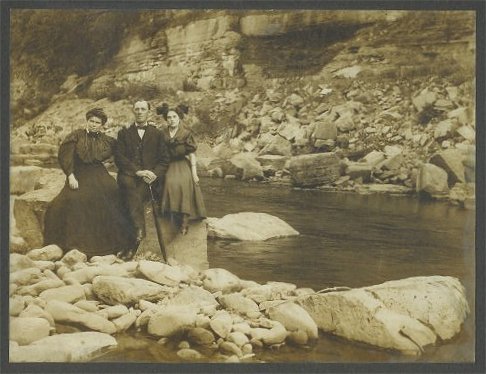
I loved this photo the second I saw it, with its formally dressed, starched-collar family perched (seemingly) comfortably atop a boulder in a rugged river canyon. Anyone who has ever hiked in the canyons of Utah or Arizona will appreciate the difficulties involved in traveling along a rock-strewn river bank in patent-leather shoes, not to mention dressing in dark, volumous clothes, as these good people were, with the harsh sun beating down on you.
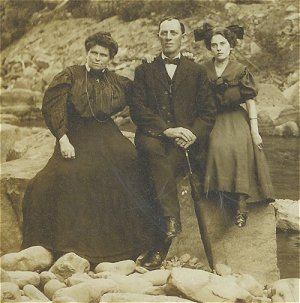
We've come a long way in terms of dressing comfortably for such activities in the past seventy-five years or so. Of course, these days we do have to change before dining at the lodge...
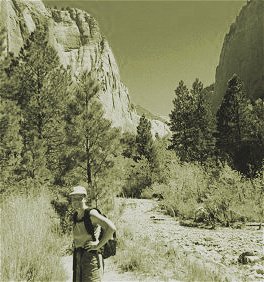
The photo shows some interesting details- a high white collar, cross and long gold chain worn by the mother, stiff collar and bowtie on the father, and short gold choker with what appears to be a cross, along with an enormous hair ribbon, worn by the daughter-
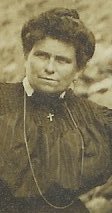

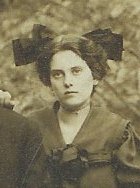
The father's shiny black dress shoes and the dainty bow-topped shoes the daughter is wearing were simply not made for climbing across wet rocks-
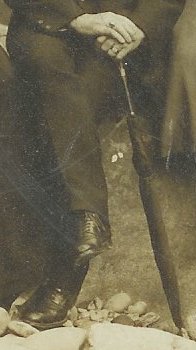


The father's umbrella and multiple gold rings, and the daughter's gold bracelet are nice touches in this wonderful picture. Obviously Victorian-era hikers were made of sturdier stuff than we are today... but maybe not. A few years ago Amy and I were visiting Bryce Canyon and we went on an afternoon hike along one of the longer trails. We'd been hiking in the back country of southern Utah the week before, and so we automatically put on our big hiking boots, and carried our backpacks with snacks and plenty of water. You're unlikely to get into too much trouble in Bryce, but hey, why take chances? Toward the end of the hike, on the way up, out of the canyon, we passed a group of French women tourists on their way down. They were all immaculately dressed and coifed, and many were wearing fashionable black pumps. Chatting happily with each other and evidently having a grand time, they could just as easily have been walking down 5th Avenue in New York. As we trudged by them in our boots and backpacks, we felt terribly over-dressed. Maybe it's all just a state of mind...
Tuesday, May 29, 2007
Memorial Day



The Smith Academy marching band won the National Marching Band Championship in Pennsylvania last week, quite an achievement considering Smith Academy has about 400 students and was competing against much larger schools-
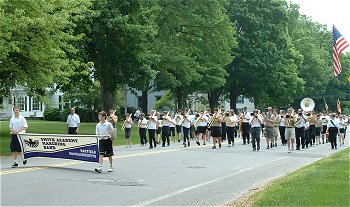



There were several speeches and VFW presentations in Smith Park afterwards. Hatfield has several service members in Iraq, and the young Marine in the background is about to be deployed there. The chaplain of the Hatfield V.F.W., who read the names of members who died this year, is in the dark blue suit on the far right; he's also my barber.
A fly-over of A-10's from nearby Westover AFB was scheduled, but did not happen during the ceremony. After the ceremony we walked home, which is only a few hundred yards down the street from the park. About half an hour later we were sitting on the deck eating lunch, and a pair of A-10s slowly flew over at about 2,000 feet, then came back around a few minutes later, as if they were looking for something... then, about a minute later they came screaming directly over our deck at about 400 mph, only 100 feet off the ground, which was quite a way to end the day!
Thursday, May 17, 2007
Really Unique Collectibles...

This op-ed piece from today's New York Times relates to one of the 20th century's more macabre collecting sagas. If I recall correctly, New York autograph & maunscript auctioneer Charles Hamilton once sold the relic, and wrote about it in one of his books, published in the 1970s. I had not heard much about it since then, but apparently it's back...
Collect-Me-Nots
By JUDITH PASCOE
New York Times: May 17, 2007
THE owner of Napoleon’s penis died last Thursday in Englewood, N.J. John K. Lattimer, who’d been a Columbia University professor and a collector of military (and some macabre) relics, also possessed Lincoln’s blood-stained collar and Hermann Göring’s cyanide ampoule. But the penis, which supposedly had been severed by a priest who administered last rites to Napoleon and overstepped clerical boundaries, stood out (sorry) from the professor’s collection of medieval armor, Civil War rifles and Hitler drawings.
The chances that Napoleon’s penis would be excised so that it could become a souvenir were improved by his having lived and died at a moment when the physical remains of celebrities held a strong attraction. Shakespeare didn’t become Shakespeare until the dawn of the romantic period, when his biography was written, his plays annotated and his belongings sought out and preserved. Trees that stood outside the bard’s former homes were felled to provide Shakespearean lumber for tea chests and tobacco stoppers.
After Napoleon’s capture at Waterloo, his possessions toured England. His carriage, filled with enticing contents like a gold tongue scraper, a flesh brush, “Cashimeer small-clothes” and a chocolate pot, drew crowds and inspired the poet Byron to covet a replica. When Napoleon died, the trees that lined his grave site at St. Helena were slivered into souvenirs.
The belief that objects are imbued with a lasting essence of their owners, taken to its logical extreme, led to the mind-set that caused Mary Shelley to keep her husband’s heart, dried to a powder, in her desk drawer. Of course, relic collecting long predates the romantic period; medieval pilgrims sought out fragments of the True Cross. In the aftermath of the Reformation, religious relics that had been ejected from monasteries joined secular collections that freely intermingled belemnites with saints’ finger bones. When Keats died, his hair took on the numinous appeal of a religious artifact.
Napoleon’s penis was not the only Napoleonic body part that became grist for the relic mill. Two pieces of Napoleon’s intestine, acquired by the Museum of the Royal College of Surgeons of England in 1841, provoked a long-simmering debate beginning in 1883. That year, Sir James Paget called the specimens’ authenticity into question, contrasting their seemingly cancerous protrusions to the sound tissue Napoleon’s doctor had earlier described. In 1960, the dispute continued in The Annals of the Royal College of Surgeons of England, long after the intestine pieces had been destroyed during a World War II air raid.
Dr. Lattimer, a urologist, could claim a professional interest in Napoleon’s genitalia. Not so its previous owner, the Philadelphia bookseller and collector A. S. W. Rosenbach, who took a “Rabelaisian delight” in the relic, according to his biographer, Edwin Wolf. When Rosenbach put the penis on display at the Museum of French Art in New York, visitors peered into a vitrine to see something that looked like a maltreated shoelace, or a shriveled eel.
Whether the object prized by Dr. Lattimer was actually once attached to Napoleon may never be resolved. Some historians doubt that the priest could have managed the organ heist when so many people were passing in and out of the emperor’s death chamber. Others suggest he may have removed only a partial sample. If enough people believe in a possibly spurious penis, does it become real?
The pathos of Napoleon’s penis — bandied about over the decades, barely recognizable as a human body part — conjures up the seamier side of the collecting impulse. If, as Freud suggested, the collector is a sexually maladjusted misanthrope, then the emperor’s phallus is a collector’s object nonpareil, the epitome of male potency and dominance. The ranks of Napoleon enthusiasts, it should be noted, include many alpha males: Bill Gates, Newt Gingrich, Stanley Kubrick, Winston Churchill, Augusto Pinochet. Nevertheless, the Freudian paradigm has never accounted for women collectors, nor does it explain the appeal of collections for artists like Lisa Milroy, whose paintings of cabinet handles or shoes, arrayed in series, animate these common objects.
It’s time to let Napoleon’s penis rest in peace. Museums are quietly de-accessioning the human remains of indigenous peoples so that body parts can be given proper burial rites. Napoleon’s penis, too, should be allowed to go home and rejoin the rest of his captivating body.
Judith Pascoe, a professor of English at the University of Iowa, is the author of “The Hummingbird Cabinet: A Rare and Curious History of Romantic Collectors.”
Sunday, May 13, 2007
Silly Sunday
Thank you. We're all refreshed and challenged by your unique point of view.
What am I? Flypaper for freaks!?
I'm visualizing duct tape over your mouth.
The fact that no one understands you doesn't mean you're an artist.
I don't know what your problem is, but I'll bet it's hard to pronounce.
Any connection between your reality and mine is purely coincidental.
I like you. You remind me of when I was young and stupid.

How about never? Is never good for you?
You sound reasonable...Time to up my medication.
I'll try being nicer if you'll try being smarter.
I don't work here. I'm a consultant.
My toys! My toys! I can't do this job without my toys!
It might look like I'm doing nothing, but at the cellular level I'm really quite busy.
At least I have a positive attitude about my destructive habits.
You validate my inherent mistrust of strangers.
Someday, we'll look back on this, laugh nervously and change the subject.
Tuesday, May 08, 2007
New Catalog-
 The Book Elves have always loved gardening, although they tend to have too little patience to be really successful at it. Plants grow slowly in the spring, that’s all there is to it, but the Elves are never lacking in ingenious ways to speed things up. The 50,000-candlepower flood lamps to give the seedlings 24-hour light for a “jump start” got shut down by the Audubon folks when the local owls began going nutty from sleep deprivation.
The Book Elves have always loved gardening, although they tend to have too little patience to be really successful at it. Plants grow slowly in the spring, that’s all there is to it, but the Elves are never lacking in ingenious ways to speed things up. The 50,000-candlepower flood lamps to give the seedlings 24-hour light for a “jump start” got shut down by the Audubon folks when the local owls began going nutty from sleep deprivation.Their next project for “getting those plants up and running at their full potential” (as they put it) involved a set of surplus Army “all-weather” loudspeakers, and endless tape loop, and a set of self-motivation tapes they bought on Ebay. It didn't end up doing much for the plants, but the local robins have been building the most amazing nests since they started playing those tapes...
But before they decided to use an old surplus hot-water heater to "bathe" the soil with hot-water and we ended up with boiled cabbages and carrots, they finished our latest catalog-
RECENT ACQUISITIONS for MAY, 2007 is now available as a printed catalog, or on our website. It features 115 books and catalogs on art and antiques, including furniture, silver, textiles, painting, metals, ceramics, and glass. Highlights include-
-A lovely copy of an important 1931 exhibition of American folk art.
-A very uncommon 1916 Pennsylvania Museum furniture exhibition catalog.
-Israel Sack's copy of an important American ceramics book.
-A scarce 1887 book on wig-making.
-The catalog to a very important 1879 Wedgwood exhibition.
-An elegant and unusual 1821 book about a set of silver buttons with engravings of 'La Chasse', inspired by Napoleon's coat.
-The 1851 memoirs of a famous American folk painter.
-A striking 1867 collection of colored designs for marquetry.
-The catalog to the first exhibition of the Pewter Collector's Club of America.
-A rare an early Tiffany & Company Centennial Exposition promotional booklet.
-The 1836 biography of the Father of the American Industrial Revolution.
-A scarce 1853 book on Pietre Dure with 2 beautiful colored plates.
and much, much more!
Request your printed copy, or browse the catalog on our website.
Sunday, May 06, 2007
Silly Sunday...
Illiterate? Write today for free help.
Auto Repair Service. Free pick-up and delivery. Try us once, you'll never go anywhere again.
Dog for sale: eats anything and is fond of children.
Stock up and save. Limit: one per customer.
Semi-annual After-Christmas sale.
3-year old teacher needed for pre-school. Experience preferred.
Dinner special - Turkey $2.35; Chicken or Beef $2.25; Children $2.00.
Now is your chance to have your ears pierced and get an extra pair to take home.
We do not tear your clothing with machinery. We do it carefully by hand.
For sale: Three canaries of undermined sex.
Great dames for sale.
Have several very old dresses from grandmother in beautiful condition.
Tired of cleaning yourself? Let me do it.
Vacation special: have your home exterminated.
Get rid of aunts. Zap does the job in 24 hours.
Toaster: A gift that every member of the family appreciates. Automatically burns toast.
For rent: 6-room hated apartment.
Used cars: Why go elsewhere to be cheated? Come here first.
Christmas tag sale. Handmade gifts for the hard to find person.
Wanted: Hair cutter. Excellent growth potential.
Wanted: Man to take care of cow that does not smoke or drink.
And now, the Superstore -- unequaled in size, unmatched in variety, unrivaled inconvenience.
We will oil your sewing machine and adjust tension in your home for $1.00.
- - -
Thursday, May 03, 2007
A New Parian Book-
 We've just gotten copies of a newly-published book on Parian, and it's a beauty!
We've just gotten copies of a newly-published book on Parian, and it's a beauty!"Parian. Copeland’s Statuary Porcelain" is by Robert Copeland. Hardcover. 8.5”x11”, 352 pages, profusely illustrated in color and b/w, dj. New. $89.50
"Parian – a high-quality, unglazed porcelain – was developed in the early 1840s by Copeland & Garrett, which was the first company to exhibit it in 1845. Its purpose was to provide small sculptures for the public at a time when full size marble statues were gracing the homes of wealthy people. Examples exhibited at the 1851 Great Exhibition stimulated the demand initiated by the Art Union of London in 1845 and promoted further in the next forty years by other Art Unions.
‘Parian – Copeland’s Statuary Porcelain’ tells this fascinating story in detail. The debate in the columns of the Staffordshire Advertiser as to which firm was the first to introduce Parian is also examined here in detail. The book goes on to describe the manufacturing processes of mold-making and the casting of the figures. Also included is a comprehensive catalogue of Copeland’s productions of statuettes, groups and portrait busts."
Tuesday, May 01, 2007
Happy May!
Friday, April 27, 2007
Father Himalaya-
 I'm afraid I'm a bit behind in blogging this week- we were in New York for four days last week through the weekend, and then I had to rush to get the new catalog to the printer. But now that's all done, and as I was sitting here, browsing through images on my computer, I came across the picture you see to the left, which is part of a very interesting tale...
I'm afraid I'm a bit behind in blogging this week- we were in New York for four days last week through the weekend, and then I had to rush to get the new catalog to the printer. But now that's all done, and as I was sitting here, browsing through images on my computer, I came across the picture you see to the left, which is part of a very interesting tale...We once had a book which had the ownership inscription of a "Father Himalaya". Being curious, I did some digging and discovered a really amazing man-
Manuel Antonio Gomes 'Himalaya' [1868-1933] was known as "Father Himalaya", and is considered to be the father of solar energy in Portugal, and a visionary pioneer in the field of renewable energy. After taking Holy Orders in the Society of Jesus he studied natural sciences, physics, chemistry, mathematics and astronomy, and traveled to France where he studied with the noted chemist Marcelin Berthelot. In 1899 he was granted a patent by the French government for a device to produce heat by focusing the sun's rays.
In 1900 he constructed a test device in the Pyrenees and attained a temperature of 1100 degrees centigrade. In 1902 an experiment in Lisbon attained 2000 degrees, and he made a final, startling demonstration of the power of such a device at the St. Louis Exposition in Missouri 1904. There he constructed his "Pireliofero" (that's it in the picture), a 3-story high parabolic mirror mounted on a monstrous iron framework which focused sunlight on an oven mounted at the top of the structure. The oven reached a temperature of 3500 degrees, melting a test chunk of basalt, and Father Himalaya won a Grand Prize for his efforts.
He promoted other forms of renewable energy as well, including tidal energy and hydroelectric power, wind power, and geothermal power. Alas, there was plenty of cheap coal and oil available, and his work was generally ignored and forgotten. Father Himalaya retired to become chaplain at Viana Castle, a charity home, where he died at the age of 65. His work has excited interest in Europe in recent years, and his ideas have only lately attained a measure of the respect which eluded them in his lifetime.
That's what I love about bookselling- you find out all sorts of things you didn't even know you were looking for.
Tuesday, April 24, 2007
Our New Books on Glass Catalog-
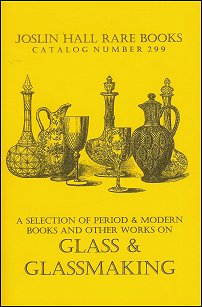 Glass and the Book Elves have always been uneasy companions, whether we are talking about flying croquet balls going through plate glass windows or the fact that if you are going to buy a rare and expensive Lalique clock on Ebay you had better make sure the trademark is spelled with a "q" and not a "k"...
Glass and the Book Elves have always been uneasy companions, whether we are talking about flying croquet balls going through plate glass windows or the fact that if you are going to buy a rare and expensive Lalique clock on Ebay you had better make sure the trademark is spelled with a "q" and not a "k"...But before their latest "let's see how high we can stack the Baccarat stemware" contest crashed down to its inevitable, messy conclusion, they finished our "Books on Glass & Glassmaking" catalog. This catalog features 151 books and other items about antique glass, glassmakers, glass technology, and the history of glass.
Highlights include-
-A 1919 history of the Worshipful Company of Glaziers.
-An 1835 guide to Crown Glass cutting and glazing, written by the "Glass Cutter, Glazier and Stained Glass-Maker to the King of Scotland".
-A bound compendium of 19th century glass patents.
-An 1898 and a 1940 history of the Worshipful Company of Glass-Sellers.
-An uncommon catalog of a leading Arts & Crafts designers' work, including stained glass windows.
-The extremely scarce true first, private, edition of the first book on American glassmaking.
-A nice 1880 glass lamp catalog.
-Two early 19th century editions of Neri's "Art of Glass", including a rare edition published by Sir Thomas Phillipps' Middle Hill Press in 1826 in an edition of 100 copies.
-A ca.1810 broadside of terms for London Plate Glass Manufacturers.
-and many standard glass reference books.
The catalog is available in printed format, or you can see it here.
Monday, April 23, 2007
Monday, Monday...

Monday, April 16, 2007
Monday, Monday...
In fact, it's so rainy here in New England that all the Patriot's Day celebrations and activities have been called off- all the parades in Concord and Arlington and the other towns, the re-enactment of the embattled farmers standing up against the British troops at Lexington Green -everything. About the only Patriot's Day acitvity going on is the Boston Marathon, and I understand that they are offering free snorkel equipment to the runners.
But even as the rain continues and I keep checking the basement for flooding, I'm reminded that there are worse ways to start the week...
I could, for example, be a human traffic light-

Sunday, April 15, 2007
Silly Sunday...
 An industrial engineer was given a ticket by his boss for a performance of Schubert's "Unfinished Symphony."
An industrial engineer was given a ticket by his boss for a performance of Schubert's "Unfinished Symphony."The next morning, the engineer sent the following note to the orchestra's conductor:
MEMORANDUM:
1. For a considerable period, the oboe players had nothing to do. Their number should be reduced, and their work spread over the whole orchestra, thus avoiding peaks of inactivity.
2. All 12 violins were playing identical notes. This seems unnecessary duplication, and the staff of this section should be drastically cut. If large volume of sound is required, this could be obtained through use of an amplifier.
3. Much effort was involved in playing the 16th notes. This seems an excessive refinement, and it is recommended that all notes should be rounded up to the nearest 8th note. If this were done, it would be possible to use paraprofessionals instead of experienced musicians.
4. No useful purpose is served by repeating with horns the passage that has already by handled by the strings. If all such redundant passages were eliminated, the concert could be reduced from two hours to 20 minutes.
5. This symphony has two movements. If Schubert didn't achieve his musical goals by the end of the first movement, then he should have stopped there. The second movement is unnecessary and should be cut. In light of the above, one can only conclude that had Schubert given attention to these matters, his symphony would probably have been finished by now.
Friday, April 13, 2007
The Value of Art...

An interesting quote from an 1862 periodical review of the loan collection of art treasures that had just gone on view at the South Kensington Museum (now the V&A)-
"Art, far more than use, is the stimulus of expenditure. A sense of art makes Mrs. Brown envy and finally outshine Mrs. Jones’s d’Aubusson carpet, though her own Brussels was but little the worse for wear. Art urges Mrs. Jones to emulate Lady Robinson’s Minton dinner-service, while her previous set (over which Jones grumbled so much at Copeland’s only the year before last, and of which but one sauce-boat and three plates are yet broken) subside to lower shelves in her pantry as second best. Art relegates to the second-hand dealer in Tottenham-court-road those armchairs which Sir John Robinson so long persisted in proving to be perfectly comfortable, by dropping off in one of them every time Lady R. delivered her tirade on their shortcomings."
Wednesday, April 11, 2007
Trilobites and Fossils and Megatheriums- OH MY!!
 In the 19th and early 20th centuries it was accepted practice to furnish museums with casts of all types, from classical statues to trilobites, and I thought I'd share some illustrations from an interesting catalog, published in 1866, which served the latter trade.
In the 19th and early 20th centuries it was accepted practice to furnish museums with casts of all types, from classical statues to trilobites, and I thought I'd share some illustrations from an interesting catalog, published in 1866, which served the latter trade.Henry A. Ward's "Catalogue of Casts of Fossils, from the Principal Museums of Europe and America, with short descriptions and illustrations" , offered a complete and comprehensive listing of fossils, from minute Ammonites to a complete Plesiosaur or a Megatherium, many taken from originals at the British Museum.

In the 1860s and 1870s dinosaurs were not yet a major subject for study- few had been discovered. Paleontologists were very excited though, by earlier plant and animal life, as shown here, and especially by another set of animals amply illustrated here- early mammals. The fight to discover and name early mammals was at least as heated as the dinosaur wars which would erupt a few decades later, because it was through these fossils that scientists were slowly attempting to prove Darwin's controversial theory of Evolution.
Ward catalogs everything in a scientific manner and also includes fossil tracks, and even replicas of the models shown at the Crystal Palace. At the rear of the catalog he offers skins and skeletons of contemporary American animals and also, grotesquely, "Aborigines -Indians of various Western Tribes: Skulls, from $15 to $25 each. (These are taken fresh, not disinterred from old graves)".

Henry Ward was one of the most interesting and omnipresent characters in Victorian natural history. After making a fortune supplying museums with natural history and paleontological exhibits he turned his attention to meteorites with the same zealous thoroughness. The chronicle of Henry A. Ward's career and various interests is well covered in Roswell Ward's 1948 biography.
I thought I'd finish here with the fold-out plate of a cast of one of the most famous fossils of the day, the Megatherium. My apologies- it's too wide to present here in a decent size unless I turn it on its' side-



